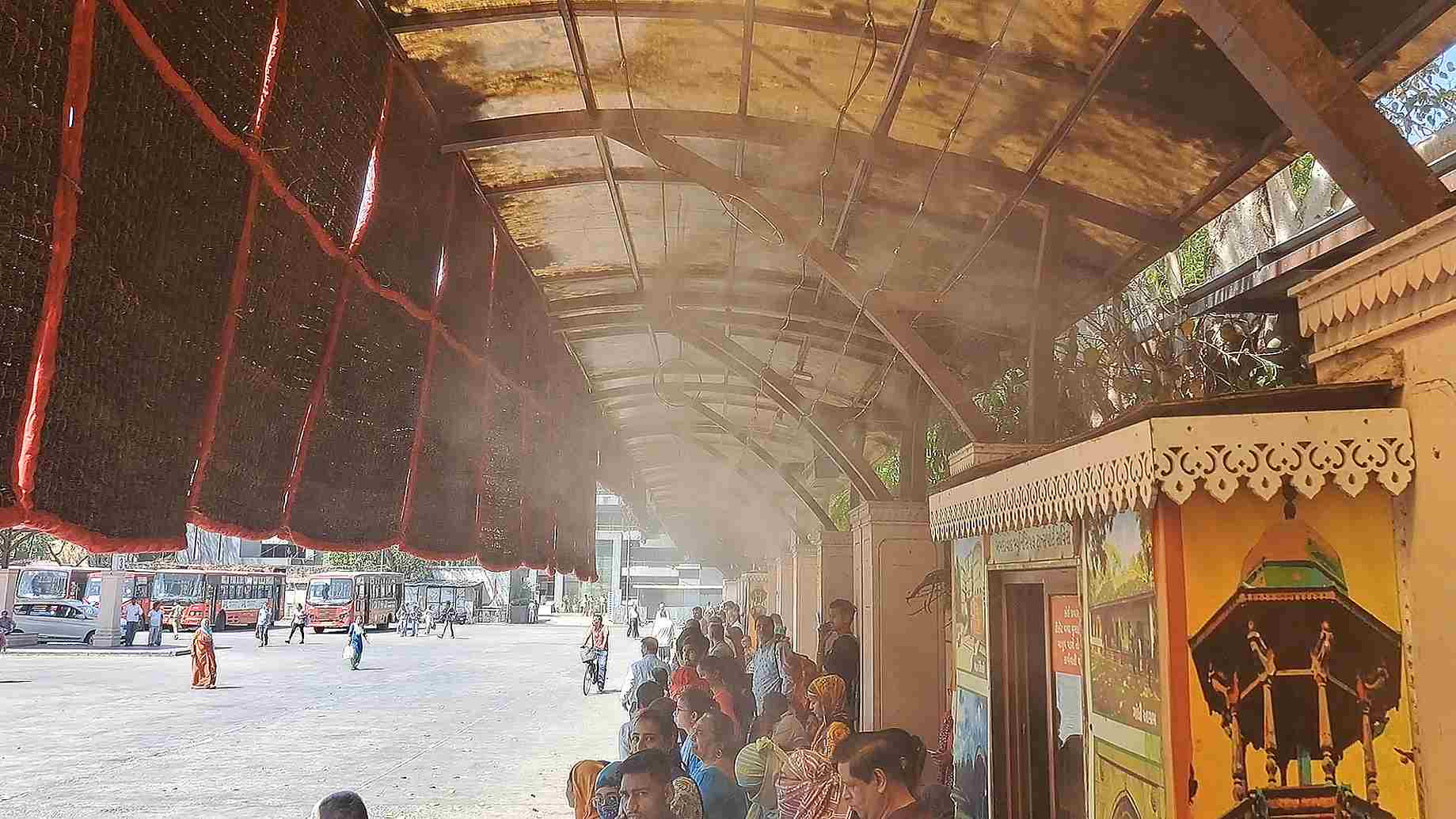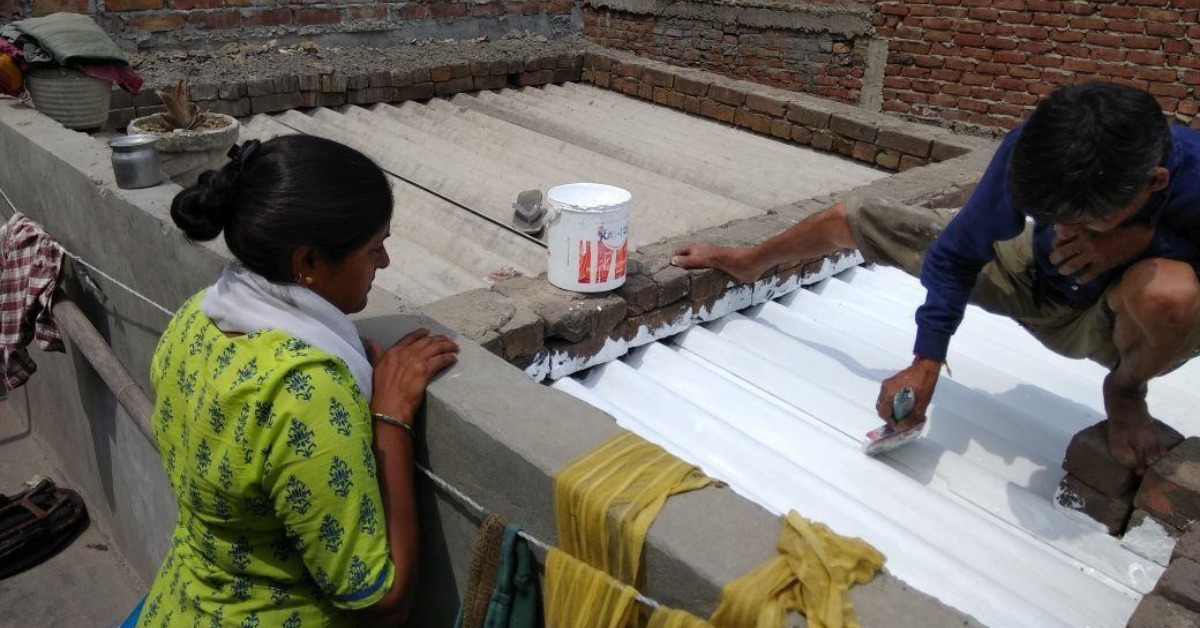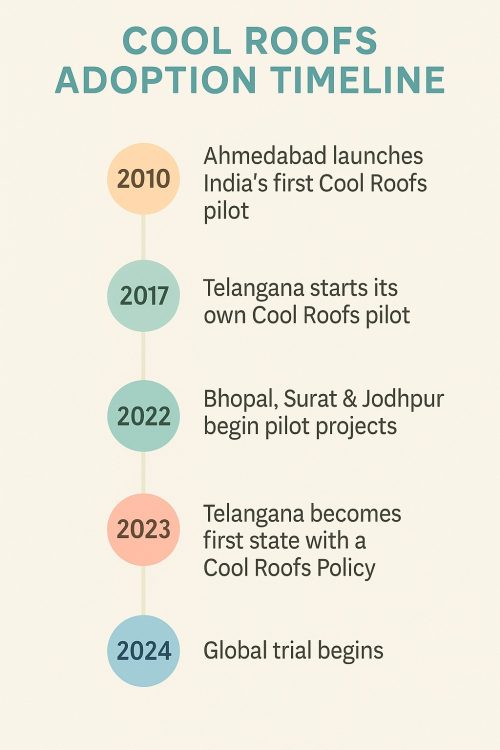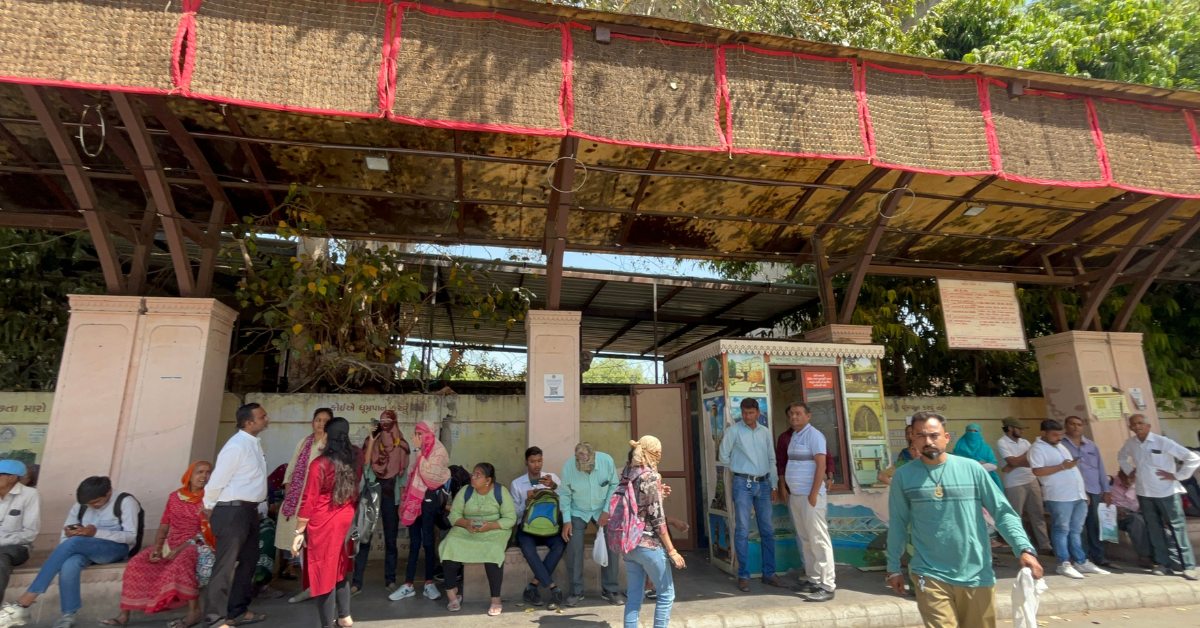Sangeeta Ben, a 30-year-old stitching worker from Sadgurukrupa Slum in Ahmedabad, has lived in the area for eight years. She supports a family of ten, including her in-laws and children, with a modest household income of Rs 15,000 per month. Her earnings largely depend on her daily income of Rs 150 as a stitching machine operator.
During the scorching summer months, however, her productivity and well-being are severely impacted by the intense heat and poor ventilation in her two-room tin-sheet home. As the temperature continues to rise each year, Sangeeta finds it increasingly unbearable. While she recognises the benefits of air conditioning, the high costs of installation and electricity make it an unattainable solution for her family.
Sangeetaben’s experience is not unique. For millions living in India’s informal settlements, the heat is more than discomfort—it’s a serious health and livelihood threat. Tin and asbestos sheet roofs trap heat, turning homes into furnaces. With climate change intensifying heatwaves across India, low-income communities are on the frontlines of this crisis.
Table of Contents
Why extreme heat is a hidden crisis in India’s slums
Long-term exposure to high indoor temperatures can cause heatstroke, fatigue, insomnia, and even high blood pressure. Research shows that tin and asbestos sheet roofs can make homes 4–6°C hotter than the outdoors—transforming already-cramped homes into stifling ovens.. Research shows that such homes can be 4–6°C hotter than the surrounding environment, posing severe risks to health and productivity. Women, especially those who work from home, are vulnerable.
The Cool Roofs Programme – a simple yet powerful fix
As rising temperatures and heatwaves become more frequent and intense across India, cities are turning to innovative, low-cost solutions to protect vulnerable communities. One such strategy is the Cool Roofs Programme—a heat-mitigation initiative rolled out in states that face extreme summer heat.
As part of the programme, rooftops are coated with a special white paint made of heat-reflective materials like Titanium Oxide. The process involves thoroughly cleaning the roof surface to remove dirt and debris before applying the paint, allowing for optimal effectiveness.

In response to escalating heatwaves, a global trial of the Cool Roofs Programme is underway — India’s Ahmedabad stands out as one of the key pilot cities testing its impact firsthand.
This initiative explores not just the temperature-lowering effects of cool roofs, but also their broader social and environmental impact on residents. Early findings from the trial suggest a promising reduction in indoor temperatures and potential improvements in health and living conditions.
“Solar Reflective White Paint is not a normal paint,” explains Dipika Vadgama, Programme Manager at Mahila Housing Trust. “Its specialised ingredients reflect sunlight rather than absorbing it. When the sun rays hit the white surface, they quickly bounce back instead of transferring heat inside the house.”
Two coats of paint are to be applied for better results.
“The application process must be done with precision,” notes Vadgama. “First, we apply one layer of paint and allow it to dry for 2 hours. Then, we apply a second layer—the first coat vertically and the second horizontally—to ensure complete coverage and maximum reflective properties.”

This paint also happens to be non-toxic due to its water-based and low VOC, indicating lower gas emissions.
Research-backed results show indoor temperatures drop by 3–6°C—transforming homes and extending working hours, especially for home-based women workers like Sangeeta.
“Our measurements show a remarkable temperature difference of 3-6 degrees after installing cool roof technology,” confirms Dipika.“This has dramatically improved the lives of home-based workers. Previously, women doing sewing work couldn’t remain indoors between 1 PM and 5 PM due to excessive heat, forcing them to move their machines outside. Now they can work continuously inside their homes, extending their productive hours and increasing their income.”
“Since we applied the solar reflective white paint, the difference in temperature indoors is remarkable. Before, it was unbearable, and I had to take breaks from my sewing to escape the heat. Now, with a cooler indoors, I can work longer hours comfortably, right here in my home. I am looking forward to applying the paint again next summer to maintain this comfortable environment for my work,” Sangeeta Ben told The Better India.
Saves energy costs
Cool roofs also reduce the use of mechanical air conditioning, resulting in significant savings in energy costs, considering the rising demand for power and the stress it exerts on the existing power infrastructure. Cool roofs are also an excellent solution for reducing the urban heat island effect, a phenomenon in which cities trap heat and become excessively hot due to their concrete construction.
Cool Roofs Programme in India
Roofs painted with white paint are now becoming a common sight in India.
Gujarat and Telangana were the first states in India to design and implement a pilot program for cool roofs. Ahmedabad Municipal Corporation and Hyderabad Municipal Corporation led the implementation in Ahmedabad and Hyderabad, respectively.
The pilot was supported by the Natural Resources Defense (NRDC), a US-based environmental advocacy group, and Mahila Housing Trust (MHT), a grassroots NGO in India. This pilot achieved a reduction of close to 3 degrees in indoor temperature of houses painted with solar reflective paint.
Later in 2021, a new pilot programme was initiated in four Indian cities: Jodhpur, Bhopal, Surat, and Ahmedabad. The initiative was once again supported by the Natural Resources Defense Council (NRDC) and the Mahila Housing Trust (MHT), both of which had previously collaborated on similar efforts.
This pilot aimed to improve thermal comfort and reduce energy consumption in low-income households through simple, cost-effective interventions. One of the key components involved applying solar reflective paint to the roofs of houses, which led to a noticeable reduction in indoor temperatures, ranging between 2 to 5 degrees Celsius, providing much-needed relief during the hot months.
In addition, the programme also facilitated the replacement of conventional incandescent bulbs with energy-efficient LED bulbs. This change contributed to lowering electricity bills for participating households and promoting long-term energy conservation.
The white roofs served as a climate-resilient intervention and a powerful outreach tool to sensitise and engage communities. Since its launch, the programme has turned over 460 rooftops white—impacting nearly 68,000 people across four cities with a simple coat of paint and a powerful promise of relief.
Trial underway in Burkina Faso, Mexico, the South Pacific, and India
Two years later, in 2023, the UK-based Wellcome Trust launched a global scientific trial to evaluate the effectiveness of cool roofs in mitigating extreme heat. This large-scale study is being carried out across four countries—Burkina Faso, Mexico, the South Pacific, and India.
The focus is on low-income areas, particularly homes with poor ventilation and tin roofs, typically occupied by communities with limited access to essential resources such as electricity, clean water, and healthcare.
These homes are highly vulnerable to the adverse effects of rising temperatures.
In India, the trial is currently underway in the Vanzara Vas slum, located in the Narol area of Ahmedabad. As part of the study, the roofs of 400 homes are being coated with white, solar-reflective paint.
While the results from India are still pending, preliminary findings from the trial in Burkina Faso are promising. Over a two-year period, homes with tin roofs experienced an average temperature reduction of 1.7 degrees Celsius.
The Ahmedabad leg of the trial is set to continue for another year, with researchers closely monitoring its long-term impact on indoor temperatures and overall well-being.
“At Mahila Housing Trust, we’ve been addressing climate change effects since 2010,” explains Vadgama. “Our approach focuses on five key stresses: air pollution, water scarcity, flooding, heat stress, and vector-borne diseases. Cool roof technology is our primary solution for heat stress, targeting the most vulnerable communities.” She emphasizes that these interventions are critical for slum dwellings that are “congested with limited space” and typically covered with “structurally weak tin or asbestos cement sheets that absorb tremendous heat.”
What are some of the challenges with implementing this programme?
Despite the proven benefits, several practical challenges exist in implementation. Despite its promise, cool roof adoption faces roadblocks—from technical skills and weak rooftops to deeper gender barriers.
“Women are most affected by indoor heat,” says Vadgama, “yet they often don’t control household budgets to approve application costs—even when they see the value.”
Structural concerns present another barrier, especially in informal settlements where many roofs are ageing or rusty, creating uncertainty about whether the paint will adhere properly.
An important gender dimension also affects adoption rates. Women experience the greatest impact from extreme indoor heat since they typically remain in these homes throughout the day for domestic and livelihood activities yet often lack financial decision-making authority within households.
In many cases, women recognise the value of cool roof technology and even purchase the paint but cannot secure approval for the additional application expenses. This gender dynamic significantly hampers adoption in the very households that would benefit most from the technology.
“For the Solar Reflective White Paint technology to reach its full potential, we need to address two key challenges,” suggests Vadgama. “First is awareness—many people simply don’t know this affordable solution exists. Second is policy integration. Every city in Ahmedabad already has a heat action plan. These plans should be expanded to include cool roof implementation at both residential and institutional levels, covering homes as well as public facilities like healthcare centers, Anganwadis, schools, and transportation hubs. This comprehensive approach would significantly amplify our impact.”

Cool Bus Stops: Another innovation with potential to beat the heat
Another innovative initiative aimed at combating rising temperatures in Ahmedabad is the Cool Bus Stop project. Launched on 8th March 2025, this pilot was introduced at Lal Darwaja—a bustling local market area—by the Ahmedabad Municipal Corporation and Ahmedabad Municipal Transport Service (AMTS), with support from the Mahila Housing Trust (MHT). The goal is to provide much-needed comfort and relief to daily commuters while they wait for buses in the scorching heat.
The Cool Bus Stop is designed using climate-responsive materials and tools that help create a significantly cooler micro-environment. At the heart of this setup is an energy-efficient, high-pressure misting system. It releases ultra-fine mist particles that evaporate quickly, reducing the ambient temperature within the bus stop. This offers immediate relief to waiting passengers and introduces a more humane and climate-conscious approach to everyday public infrastructure.

The innovation uses a high-pressure misting system that creates a cooling effect through evaporation. “The water is pumped out of the nozzle at a pressure of 0.2 microns. The particle breaks at a pressure of 5 to 15 microns and creates fogging,” explains Dipika. She adds that the cool bus stops particularly benefit “people like senior citizens who have dehydration problems and daily wage workers who do a lot of physical work. If they get some comfort, it has a positive impact on their body and mind.”
The innovation uses less energy than traditional air cooling conditioners, which have features such as timers and adjustable pressure. It also ensures dust suppression and uses khus curtains to ensure natural cooling and act as a barrier between the hot and cool air.
“The scale of impact is remarkable,” notes Vadgama. “Over a single season, more than 6 lakh commuters will benefit from this cooling technology. When you calculate the cost per person served, it emerges as an exceptionally economical intervention for heat mitigation in public spaces.”
The impact of Cool Bus Stops has been tremendous. The Cool Bus Stop consistently recorded temperatures 5–7 degrees lower than regular bus stops. The highest temperature difference of 6.8 degrees was observed on 30th March, showcasing substantial heat mitigation.
“This shaded area will provide cool air and bring relief to people during the summer. It will help protect them from heatstroke and other heat-related illnesses. I sincerely congratulate the AMC, AMTS, Mahila Housing Trust, and the entire team for this initiative. I hope similar technology will be implemented on other platforms in the future as well,” said Shri Pratibhaben Jain, Mayor, Ahmedabad, on the launch of the Cool Bus Stop.
“This is very relaxing for the poor people like us. We are mason labors, and using this
bus-stop regularly in the summer. We have never seen such a thing. This kind of facility is really good for the people like us,” said a woman daily wage labourer.
This first-of-its-kind ‘Cool Bus Stop’ marks a significant step towards climate resilience in Ahmedabad. By improving comfort in public spaces, this initiative sets an example for other cities in India to prioritise public health and well-being in the face of rising temperatures.

In this column, TBI editorial brings you articles from experts across India, tackling the challenges that matter most. These insightful pieces offer practical solutions and inspire us to take proactive steps in addressing the issues we face in our communities and beyond.
Edited by Leila Badyari and Vidya Gowri Venkatesh
Source Link: thebetterindia.com
Source: thebetterindia.com
Via: thebetterindia.com


























